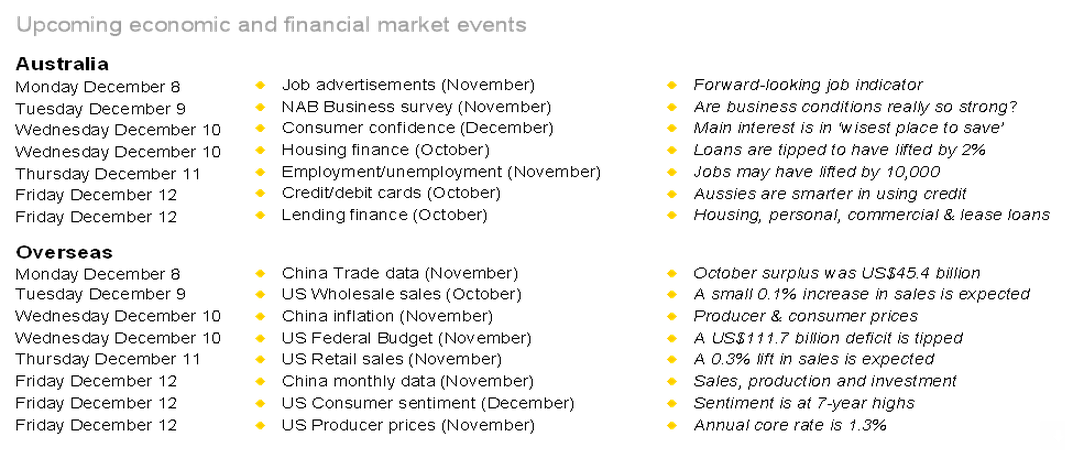The Week Ahead
Jobs, jobs, jobs
If the Reserve Bank was to change its tune on rates, the job market would play a big role. At present the tune is quite dull, with the Reserve Bank going out of its way to indicate that rates will stay unchanged for an extended period.
The Reserve Bank is working on the assumption that economic growth will be decidedly unspectacular in 2015, growing at, or slightly below, the long-term average pace. And that means that there will be no substantial lift in the job market.
But what if there was a lift in the job market? The Reserve Bank would conclude that greater demand for jobs means higher wages, and, in turn, higher prices.
Aussie businesses are seeking to hire more staff. In fact job advertisements have lifted for five straight months. Investors will watch carefully if this trend continued last month with the job ads data out on Monday.
But is this hiring pace strong enough to offset those exiting jobs? The answer will come on Thursday in the shape of the latest data from the Bureau of Statistics. After rising by 24,100 in October, we think employment advanced by another 10,000 people in November. The unemployment rate probably held steady near 6.2 per cent.
If employment was to rise by closer to 30,000 in November and unemployment fell towards 6 per cent, then the Reserve Bank would start questioning whether the policy of low and stable interest rates has had its day. Clearly it would take more than one month's worth of data to change views, but a journey starts with the first step.
Of the other economic data, the ANZ/Roy Morgan weekly consumer confidence survey results are released on Tuesday followed by the less timely Westpac/Melbourne Institute monthly consumer sentiment results on Wednesday.
The main value of the monthly survey now is the additional survey questions that are posed each quarter. And the upcoming December survey includes these extra questions, notably consumer views on the wisest places for savings. Despite low rates, banks are the favoured savings destination at present.
Also on Tuesday, the NAB business survey is released for November. And this survey will attract more than the usual attention given the fact that the October survey revealed the largest increase in business conditions in 16 years. And the actual reading on business conditions was the highest in 6½ years. If the strong October readings are validated in the November survey then it could signify a change in economic momentum, especially if the job data is similarly strong.
Lending data also will attract attention over the coming week. On Wednesday, data on housing finance is released while the broader lending finance figures are issued on Friday together with figures on credit and debit card lending from the Reserve Bank. Based on Bankers Association data, new home loans probably rose by 2 per cent in October.
Overseas: Chinese economic data in the spotlight
There are sparse helpings of ‘top shelf' US economic data in the coming week with the main interest in retail sales on Thursday. But all the key monthly Chinese indicators are issued.
The week kicks off on Monday with the release of Chinese trade (exports and imports) figures for November. The trade surplus is significant at present at US$45.4 billion, suggesting there are still healthy global markets for Chinese goods.
On Tuesday, the focus shifts to the US with monthly wholesale sales and inventories figures and the weekly chain store sales figures.
On Wednesday in the US the weekly housing finance figures are issued together with the monthly federal budget report. Meanwhile in China, inflation figures are released – the data on producer and consumer prices. Producer prices are still in decline, down 2.2 per cent over the year. And consumer prices are rising at a modest 1.6 per cent annual rate. Further tame inflation readings would leave the door open to rate cuts.
On Thursday in the US the usual weekly data on claims for unemployment insurance (jobless claims) is issued together with November retail sales data. There has been much debate about the strength of sales around Thanksgiving Day – some suggesting that Black Friday sales were soft because sales had been brought forward. So the data will end some debates.
And then on Friday, the US business inflation figures (the producer price index) are issued together with consumer sentiment. In contrast to China, US producer prices are growing modestly, up 1.3 per cent over the year.
Also on Friday, China's National Bureau of Statistics issues data on retail sales, production and investment. While production growth is slowing, retail sales growth is firm.

















